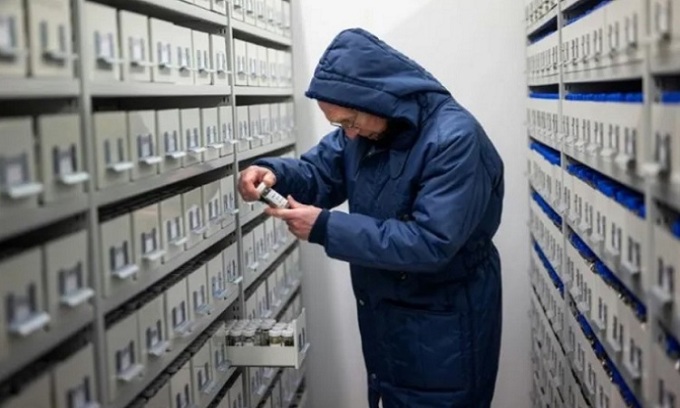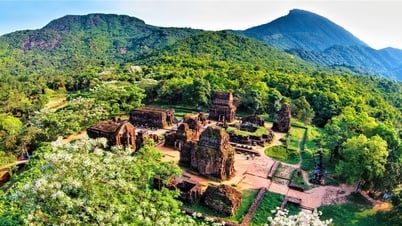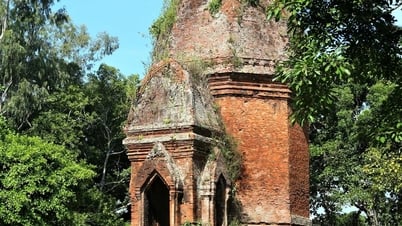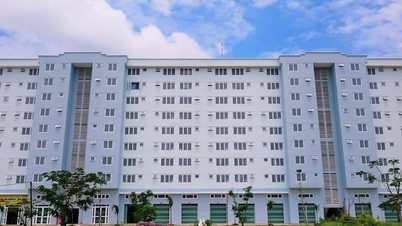A bomb-proof freezer in the English countryside holds a treasure trove of 40,000 wild plant seeds from around the world, many of which are at risk of disappearing.

Shelves of seeds from around the world in the MSB vault. Photo: AFP
The world's largest seed bank, located in the south London countryside, is in a race against time as two in five plant species are threatened with extinction. David Attenborough, the famous British naturalist, said the Millennium Seed Bank (MSB) "may be the most important conservation initiative ever".
According to John Dickie, the project’s lead researcher, the aim is to conserve wild plants through seed, preventing extinction in the long term. He has been involved with the MSB project since its conception in the late 1990s and opened the current facility in 2000 to mark the millennium.
A total of 2.5 billion seeds are stored at MSB in Wakehurst, 35 miles (56 km) from London, and at a branch of Kew Botanic Gardens in the capital. They come in all shapes, colours and sizes, from 40,020 different species originating from 190 countries.
Nearly 20% of the world's plants are conserved at Wakehurst, with priority given to species threatened, particularly by climate change, and endemics that are unique to a single geographical area. Plants with functions such as medicinal or economic value are also given priority. "Many plants become endangered for a number of reasons, but mainly through land-use change and climate change. Some will adapt. Some won't. At least they're here instead of disappearing," Dickie says.
Wakehurst receives new seeds from around the world every week, then the preservation process begins. It’s based on technology already used on many crops. Once dried and frozen, the seeds can be stored for decades, even centuries.
Dickie’s team consists of about 20 researchers and many volunteers working in the lab. One of them is Lucy Taylor, who is working with Albizia polyphylla seeds from Madagascar. Her job involves separating the empty seeds from the rest. “Many of the seeds are either damaged or infested with pests, so it’s important to clean them as much as possible. We want to have the best quality collection because space in the vault is limited,” Taylor said.
Researchers X-ray the seeds to check for disease, and each seed is given an identification tag with its name, origin, and date of arrival at MSB. They then store the seeds in glass jars before placing them in underground -20C cryogenic vaults designed to withstand floods, bombs, and radiation. The largest collection of seeds comes from the orchid family. But there are also rare plants, such as the world’s smallest water lily and Deschampsia antarctica, one of only two flowering plants native to the icy continent.
An Khang (According to IB Times )
Source link


![[Photo] Prime Minister Pham Minh Chinh meets with the Policy Advisory Council on Private Economic Development](https://vphoto.vietnam.vn/thumb/1200x675/vietnam/resource/IMAGE/2025/5/8/387da60b85cc489ab2aed8442fc3b14a)
![[Photo] National Assembly Chairman Tran Thanh Man chairs the meeting of the Subcommittee on Documents of the First National Assembly Party Congress](https://vphoto.vietnam.vn/thumb/1200x675/vietnam/resource/IMAGE/2025/5/8/72b19a73d94a4affab411fd8c87f4f8d)
![[Photo] General Secretary To Lam begins official visit to Russia and attends the 80th Anniversary of Victory over Fascism](https://vphoto.vietnam.vn/thumb/1200x675/vietnam/resource/IMAGE/2025/5/8/5d2566d7f67d4a1e9b88bc677831ec9d)
![[Photo] General Secretary concludes visit to Azerbaijan, departs for visit to Russian Federation](https://vphoto.vietnam.vn/thumb/1200x675/vietnam/resource/IMAGE/2025/5/8/7a135ad280314b66917ad278ce0e26fa)

![[Photo] President Luong Cuong presents the decision to appoint Deputy Head of the Office of the President](https://vphoto.vietnam.vn/thumb/1200x675/vietnam/resource/IMAGE/2025/5/8/501f8ee192f3476ab9f7579c57b423ad)











![[Video] Institute of Social Science Information celebrates 50th anniversary](https://vphoto.vietnam.vn/thumb/402x226/vietnam/resource/IMAGE/2025/5/8/541d6946f8a14ed3824d7a3edafc652c)















































![[Photo] Prime Minister Pham Minh Chinh talks on the phone with Singaporean Prime Minister Lawrence Wong](https://vphoto.vietnam.vn/thumb/402x226/vietnam/resource/IMAGE/2025/5/8/e2eab082d9bc4fc4a360b28fa0ab94de)































Comment (0)